
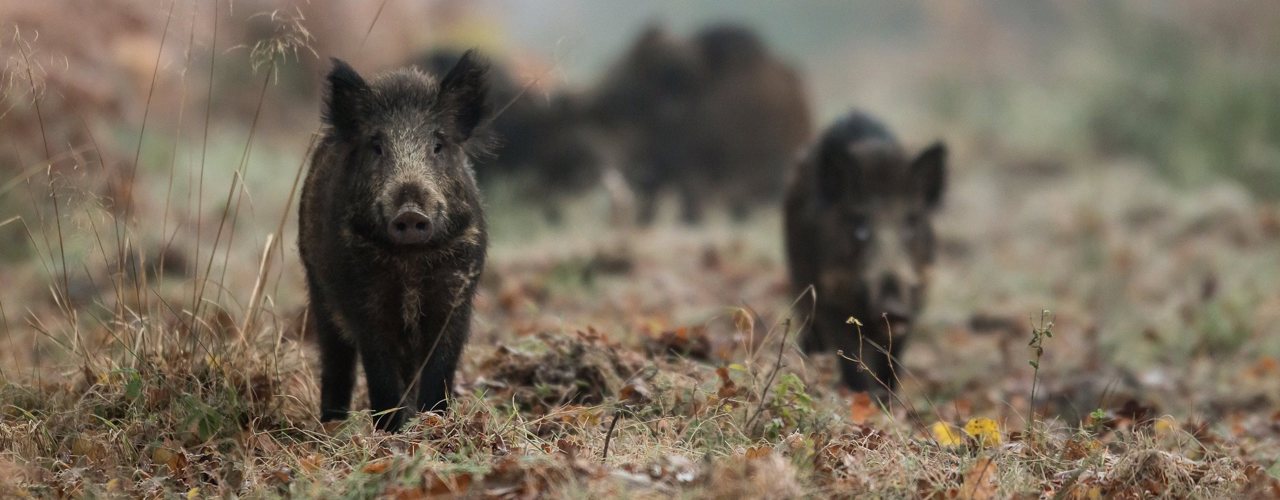
Separating Fact from Fiction: The Threat of Canada's "Super Pigs"
Recent reports from popular articles and Canadian news outlets have made sensational claims about wild swine (Sus scrofa), suggesting that a new breed of “super pigs” is expanding their range to the United States. Accounts generally allege that this new breed, weighing ~600 lbs., now exists through natural selection within existing wild pig populations or hybridization between feral swine and Eurasian boar. Are these accounts accurate, or is the media exaggerating a small number of reports? Without concrete scientific date, we can only examine the legitimacy of a new, larger breed of "super pig" by stepping through some questions and scenarios:
- Where might the newly coined "super pig" fall among other pig groups?
- How do observed super pig weights compare to known feral swine and Eurasian boar weights?
- Could it be possible for a larger new breed to originate and sustain its populations?
- What could the origins of a new “super pig” mean as a threat to agriculture and ecosystems in the United States?
The Name Game: Sorting North American Pig Monikers
In North America, there are three types of pigs free-ranging on the landscape: feral swine (domestics gone wild), Eurasian boar (the wild type specimen), and their hybrids. Collectively, they fall into the same genus and species, Sus scrofa; however, colloquially, they are called different names (Table 1). Eurasian boar are the wild type, a term used in the discipline of genetics meaning the typical, or original form of a species (Figure 1). They were originally introduced to North America and released in relatively small numbers for hunting purposes, rather than for domestic pork production, and their distribution was localized within states. Because few initial and subsequent introductions occurred in North America, their breeding with escaped or released domestic swine has likely diluted their genetic line over time.
"Super pigs" are assumed to be feral swine. More history of wild pigs and how they became so prevalent can be found here; to summarize, we now face free roaming feral swine with similar traits to both domestic swine and Eurasian boar in both the U.S. and Canada.
|
TYPES OF WILD PIGS IN NORTH AMERICA |
OTHER COMMON NAMES |
|
Eurasian Boar Wild type specimen |
Russian Boar, Wild Boar, Eurasian Wild Boar, Russian Wild Boar, Old World Swine |
|
Feral Swine Domestic Pigs (Escaped/Released) |
Feral Hogs, Wild Swine, Feral Pigs, Razorback, Piney Woods Rooters, Wood Hogs, Super Pigs |
|
Hybrid Wild Pigs |
Feral Swine, Feral Hogs, Wild Swine, Feral Pigs, Razorback, Piney Woods Rooters, Wood Hogs, Super Pigs |
Table 1. North American wild pigs in occur in three types but have many common names.

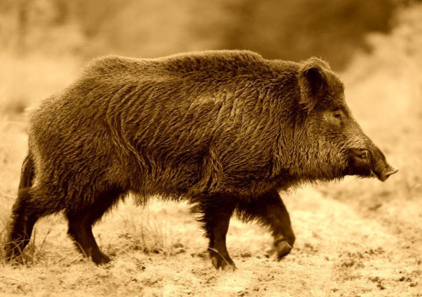
Figure 1. Eurasian boars were introduced to North America in small numbers for hunting purposes, rather than pork production.
Does bigger body size make sense in colder climates?
Bergmann’s (1847) and Allen’s (1877) rules explains that similar characters (longer and thicker bodies and shorter thicker limbs, respectively) are similar among different wildlife species in northern latitudes as an adaptation to conserve heat in colder climates. Both rules generally hold true and are widely observed among a variety of animals in nature, particularly among warm blooded mammals (Shelomi and Zeuss 2017) and the body type of feral swine and Eurasian boar fit the bill. Super pig weights are purportedly much higher than feral swine and Eurasian boar recorded by scientists, so can such a breed be real?
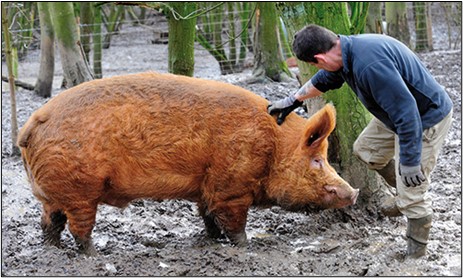
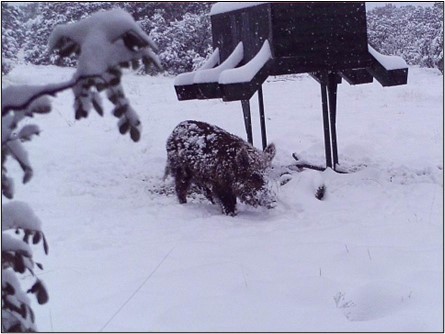
Figure 2. Wild pigs in colder climates adapted traits such as relatively larger body sizes, increased body hair, and increased body fat over successive generations (Rothschild & Ruvinsky 2011; Markov et al. 2022).
The original (wild type) Eurasian boar developed adaptations like these to survive in the coldest climates of their native range of Eurasia thousands of years ago (Rothschild & Ruvinsky 2011; Markov et al. 2022), with Siberia (up to 61°N) as their northernmost naturally colonized region (Markov et al. 2022). Eurasian boar males sampled in the Czech Republic of Europe (at equal latitude to much of Canada), had an average weight of 233 pounds (Drimaj et al. 2019). In the United States, Mayer (2021) reported on a 52-year dataset, having a large sample size (n=12,257) that the average body weight of wild pigs was 83 lbs. with some heavy individuals (330+ lbs.) making up a small portion of those in the data set. Average weights in both studies were far from the 600 lb. mark cited for super pigs.
Domestication of Eurasian Boar and the potential for large-size traits
Domestication of Eurasian boar eventually resulted in hundreds of domestic breeds being observed today. Selective breeding and its influence on feral swine are important to recognize, as marked increases in reproductive output and growth (Wehr 2021) are desired in farmed pigs. When these traits are coupled with best husbandry practices, costs decrease and pork production increases (Merks et al. 2011, Wehr 2021).
As a supersized example, the Tamworth pig, a domestic breed common in Canada and bred to thrive in cold northern climates, according to the Livestock Conservancy, originated in England and were imported to North America in 1882, and later into Canada after 1888. When mature, both males and females can weigh 500-600 lbs. They are much larger than both Eurasian boar in their native range (Drimaj et al. 2019), or even the largest wild pigs observed by Mayer (2021).
Selection criteria for Tamworth pigs included larger size for meat production (Figure 3), intelligence, docility, and large litter sizes and a metabolism adapted to low energy foods common to cold environments. New breeds can indeed emerge from controlled mating, but for this breed or similar ones to influence the traits of feral swine, large numbers would be required to interbreed with feral swine to pass on a variety of traits, including their 600+ lb. body size.
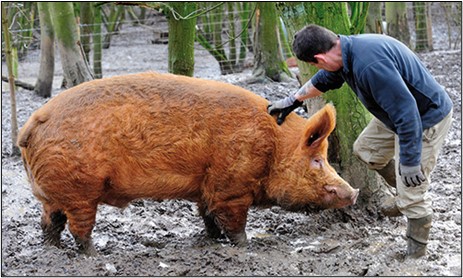
Figure 3. The Tamworth pig is a breed of domestic pig imparted with a number of specific traits including a 600-pound body size capacity to allow it to thrive as a production animal in cold climates. (Image Credit: https://www.britishpigs.org.uk)
The reality of super pigs in nature
Nature regulates feral swine body size through the availability of resources found on the landscape (e.g. food, water, shelter, and space). If this were not true, Mayer (2021) would have likely observed far more individuals exceeding 300 lbs., rather than the few recorded. At the same time, Eurasian boar would have likely adapted to have much larger body sizes, overall. Feral swine over 400 lbs. do occur, but they are rare in their population. For wild pigs to gain high weights, they must have a dependable food supply within a relatively small area. For example, those with access to feed lots, granaries, or large grain fields can obtain body weights higher than average.
Wild pigs expanding across Canada do not appear to be a new breed of wild pig, and while some individuals may be exceptionally large, they are no more “super” than other wild pig populations already established across the world. It is unlikely that “super pig” individuals will become the norm in feral swine populations in Canada; likely accounts of “super pigs” are based on the exception, not the rule, and a few encounters of these very large individuals have been sensationalized in the media.
As scientists we look for robust data sets like Mayer’s (2021), with 12,000 sampled pigs to determine average weights over time, but recent accounts of super pigs seem light on data and heavy on observations. Whatever the outcome, feral swine cause billions in agricultural damages, annually and negative effects with undetermined financial damage on wildlife and their habitats, streams and rivers and the ecosystem they flow through. Consequently, it will take a large constituency of livestock producers, conservation professionals, the hunting public and many more groups to curb problems caused by feral swine. Super or not, feral swine will continue to wreak havoc on the landscape without the application of proper management practices.
The call for wild pig control and outreach
In the US, state and federal agencies, in collaboration with farmers, ranchers and wildlife professionals, have developed strategies including direct control and public outreach programs tailored to reduce feral swine populations. The Feral Swine Eradication and Control Pilot Program focuses on direct control methods including aerial gunning, night hunting utilizing thermals, and large-scale trapping efforts to take large numbers of feral swine. This is supplemented by outreach and public education, and incentive-based initiatives including trap loan programs, which provide landowners access to remotely triggered traps for example. The Texas A&M Natural Resources Institute promotes the conservation and stewardship of private and public lands and has many educational pieces that help to explain biology and trapping methods. For more information about wild pigs or outreach efforts on wild pigs, please contact: Josh Helcel, Project Coordinator, Texas A&M Natural Resources Institute, Josh.helcel@ag.tamu.edu, or James “Jay” Long, Project Coordinator, Texas A&M Natural Resources Institute, James.long@ag.tamu.edu.
Literature Cited
- Chen, J., I. Jakovlić and J. Zhong. 2022. Whole-genome sequencing reveals positive selection on genes and variants underlying the climatic adaptation of cold-region wild boar. Authorea 1-24.
- Drimaj, J., J. Kamler , M. Hošek, J. Zeman, R. Plhal, O. Mikulka, and T. Kudláček. 2019. Reproductive characteristics of wild boar males (Sus scrofa) under different environmental conditions. Acta Veterinaria Brno (88)401–412. https://doi.org/10.2754/avb201988040401
- Markov, N., A. Economov, O. Hjeljord, C.M. Rolandsen, G. Bergqvist, P. Danilov and A. Senchik. 2022. The wild boar (Sus scrofa) in northern Eurasia: a review of range expansion history, current distribution, factors affecting the northern distributional limit, and management strategies. Mammal Review https://doi.org/10.1111/mam.12301
- Mayer, J.J. 2021. Body mass variation in an introduced wild pig population with changing ancestry. Savannah River National Laboratory, United States. SRNL-STI-2021-00110
- Merks, J.J. 2000. One century of genetic changes in pigs and the future needs in the challenge of genetic change in animal production (ed. WG Hil, SC Bishop, B McGuirk, JC McKay, G Simm and AJ Webb). British Society of Animal Science, Edinburgh pp. 8–19.
- Merks, J. W. M., P. K. Mathur, and E. F. Knol. 2012. New phenotypes for new breeding goals in Pigs. Animal (6)535–543.
- Rothschild, M. F. and A. Ruvinsky. 2011. The genetics of the pig. CABI Digital Library 1-494. https://www.cabidigitallibrary.org/doi/book/10.1079/9781845937560.000
- Shelomi, M. and D. Zeuss. 2017. Bergmann's and Allen's rules in native European and Mediterranean Phasmatodea. Frontiers in Ecology and Evolution (5)25. doi: 10.3389/fevo.2017.00025. https://www.frontiersin.org/articles/10.3389/fevo.2017.00025/full
- Wehr, N.H. 2021. Historical range expansion and biological changes of Sus scrofa corresponding to domestication and feralization. Mammal Research (66)1–12.
Learn More
Wild pig control outreach and education
Educating and equipping landowners and stakeholders to manage the growing population of wild pigs in Texas







